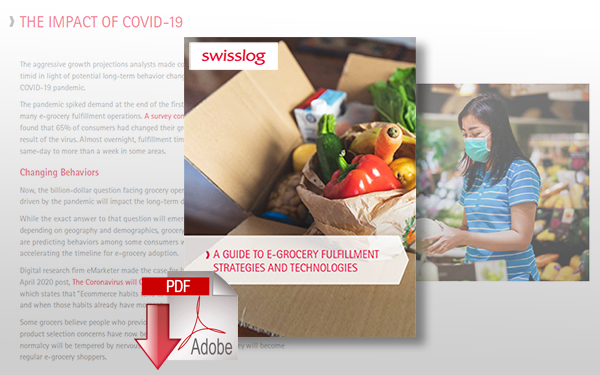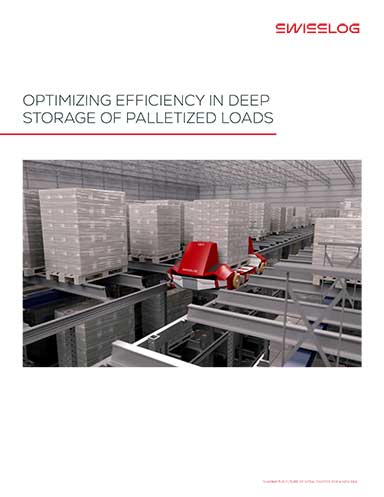Amazon’s Latest Grocery Store Concept Opens in Los Angeles With High-Tech Dash Carts

Amazon.com Inc today said it is opening a supermarket in Los Angeles with high-tech shopping carts that let customers skip checkout lines, as the e-commerce giant builds out its offline presence.
The $900 billion U.S. Grocery Industry
As reported by PYMNTS.com, Amazon.com is ready to do battle with supermarket giants Kroger Co. and Albertsons Cos. Inc. in the $900 billion U.S. grocery industry, by opening a Los Angeles supermarket today that will feature the next generation shopping cart (Reuters).
The First Amazon Fresh Grocery Store
The Amazon Fresh grocery store - a new grocery store designed from the ground up to offer a seamless grocery shopping experience, whether customers are shopping in-store or online.
Amazon has taken its decades of operations experience to deliver consistently low prices for all, and FREE same-day delivery for Prime members.
Customers shopping Amazon Fresh will find a wide assortment of national brands and high-quality produce, meat, and seafood.
Plus, Amazon's culinary team offers customers a range of delicious prepared foods made fresh in-store every day.
They have also introduced new ways to make grocery shopping more convenient, including the Amazon Dash Cart, which enables customers to skip the checkout line, and new Alexa features to help customers manage their shopping lists and better navigate our aisles.
Using the all-new Amazon Dash Cart, customers simply place their bags in the cart, sign in using their Fresh QR code in the Amazon app, shop, and exit through the Dash Cart lane to automatically complete their payment.
The cart uses a combination of computer vision algorithms and sensor fusion to identify items put in the cart.
Customers can find items in the store more quickly by using Alexa and Alexa shopping lists.
When customers arrive in store, they can access their Alexa shopping list through the Amazon app or on the Amazon Dash Cart, enabling them to quickly navigate aisles and check off items as they shop.
Throughout the store they have Amazon Echo Show devices available to ask Alexa for help - simply say, “Alexa, where can I find the hot sauce?”
The COVID-19 Pandemic
The Verge reports that although this is the first time an Amazon Fresh will open for in-person shopping, the store has been used to fulfill online orders since April.
Speaking to CNBC, the vice president of Amazon’s Fresh stores said this wasn’t its “initial plan,” but that the company responded to the surge in demand for online orders caused by the COVID-19 pandemic.
Amazon declined to comment to CNBC on when its other online-only Fresh stores in Naperville in Chicago and Irvine and Northridge, California, will open to the public.
The Amazon Fresh store will continue to offer online shopping services in addition to in-person shopping.
Amazon says it will offer free same-day delivery for Prime members, and there are also in-store pickup options for online orders.
Customers can pick up orders from an in-store service counter, or else by using a “dedicated pick-up parking spot.”
Amazon says the store will be using a number of measures to help prevent the spread of COVID-19.
Capacity will be limited to 50 percent, and both customers and employees will be required to wear face coverings while in the store.
Customers will be offered free disposable masks, and employees will have their temperature checked on a daily basis.
So What’s Behind the Empty Grocery Shelves?
Panic buying, hoarding, supplier shortages, and manufacturing capacity have all contributed to shortages everyone is experiencing at the grocery store
The COVID-19 pandemic has affected many aspects of people’s lives. Companies’ supply chains were affected, unemployment rates rose dramatically and the government-imposed stay-at-home orders rendered grocery stores nearly our only source for food and other necessary household products. Shortages inherently occurred; the causes for the shortages varied, as did their durations. After several weeks, many shortages were resolved but paradoxically returned as states began to reopen.
In May, we published a first look at grocery shortages based on information we had received from grocers through the early months of the pandemic. Since then, we received extensive data for the first six months of 2020 from a regional grocery store chain to research their shortages and investigate the industry’s pandemic-related inventory challenges.
We also had unfettered access to managers. The company’s supermarkets span multiple states and are diverse; they service towns as small as 15,000 people and cities with more than five million residents. We investigated various supply chain challenges felt by the company’s procurement and distribution teams, their suppliers, and their supermarket managers and employees. We identified both demand-disruption and supply-disruption reasons for shortages. A variety of factors were recognized that impact the length and severity of the grocer’s out-of-stock situations.
Direct pandemic-related demand disruptions
As the United States population became aware of the pending peril of the novel coronavirus, consumer purchasing behavior changed rapidly. Retailers quickly felt the effects of direct, pandemic-related demand disruptions. A short-term run on bottled water was an example of panic-buying based on unfounded fears of potential water scarcity. The feared water shortages never materialized, as retail bottled water inventories quickly recovered. Some stores experienced shortages for less than a week.
Sanitizing items, however, are not typically purchased in significant quantities by grocery stores. During the viral pandemic – demand surged and shortages erupted. Inventories are currently increasing for sanitizing products and personal protection equipment (PPE); however, demand is still not adequately met. Hand sanitizer is a relatively simple product to produce. Merely a bottle, ethyl alcohol, and aloe are required. The supermarket stores began having adequate quantities of hand sanitizer within ten weeks of the first shortages. In contrast, keeping sanitizing wipes on grocery store shelves is proving very difficult. During the final weeks of June, 56.2% of stores stocked out of sanitizing wipes on any given day. Production of sanitizing wipes is more complicated than for hand sanitizer. Manufacturing is at capacity.
Pandemic-related channel-based demand disruptions
Government-imposed stay-at-home orders have drastically increased the amount of food and household products we consume at home. Toilet paper received much attention in the early phases of the COVID-19 pandemic. The popular media frequently blamed consumers for toilet paper shortages. Articles about panic buying and hoarding appeared in numerous media publications.
Early in the pandemic, panic buying certainly contributed to toilet paper stockouts. However, panic buying is a temporary phenomenon. There is enough domestic toilet paper production capacity. Curiously, as society implemented social distancing, a persistent toilet paper shortage evolved. Obeying the stay-at-home orders, most people were no longer using the restrooms at their schools, restaurants, hotels, and workplaces
Regardless of the venue, individual toilet paper requirements are constant. Georgia-Pacific estimates that we must purchase 40% more toilet paper by remaining solely at home than when we use more varied toilet facilities. Most toilet paper mills are optimized to produce toilet paper for only the commercial or retail channel. Transitioning toilet paper supplies from one channel to another is challenging. Through efforts by suppliers and creative sourcing by the grocer, supermarket stores resumed having adequate toilet paper on shelves within eight weeks.
Unlike toilet paper, the packaging is often the only product difference between the commercial and retail consumer food channels. When restaurant dining options diminished because of the pandemic, households began preparing more meals at home; spaghetti became abundantly popular. Spaghetti was also subject to brief panic buying and sustained stockouts; there was a brief pause before replenishment. The supply recovery for spaghetti took about five weeks.
Large-scale retail pasta producers typically are multi-channel suppliers. With the collapse of the foodservice industry’s demand, pasta suppliers switched to retail packaging. The grocer’s pasta suppliers, DeCecco, Riviana, and their private label supplier, also produce for the foodservice industry (see Figure 1).
When restaurants began reopening towards the end of May, the overall demand for spaghetti increased. During late May, spaghetti stockouts at the supermarket stores resumed. Shortages continued throughout June. Home-based spaghetti consumption remained elevated even as restaurants were reopening. Channel-based competition for pasta products occurred between grocery stores and the foodservice industry.
Commodity baking products sell through retailers and are used by the foodservice industry. Commercial bread production has continued during the pandemic, and bread sales in supermarkets increased. Home baking has become popular again, and demand for retail baking commodities has risen correspondingly. Baking items like flour and sugar were often unavailable in the early stages of the pandemic, but their availability on store shelves has recovered.
The retail demand for dry yeast has increased, and keeping it in stock has proven challenging. The grocer has a single brand of yeast, Fleishmann’s, and the product had never previously suffered significant stockouts. However, on average, less than 39% of the supermarkets had dry yeast available during the final weeks of June. Many grocery store food producers and even beer manufacturers require yeast. Yeast production may have reached full capacity, and retail shortages may persist.
Unlike most items at supermarkets, beer, soda, and many snack foods are often delivered and stocked by the supplier. For sodas, direct store delivery allows bottlers' control of shelf-inventory management. It permits the bottler oversight of pricing and promotions - the retailer benefits by essentially outsourcing the management of fast-turning products. In the states where the grocer operates, the beer must be delivered and stocked by licensed distributors. Even though beer sales have generally increased during the COVID-19 pandemic, there was never a complete category-wide stockout. Individual beer brands did stock out, but the stockout rate was not appreciably different than before the pandemic.
Like beer, soda sales at the grocer have increased by approximately 15% during the pandemic, but soda never wholly stocked out. Distributors of beer and soda typically service multiple local channels. Locally-operated multi-channel distributors are proving more resilient to channel-shifts in demand. Beer and soda distributors deliver to the foodservice industry, vending locations, and retailers. Most of their products are interchangeable and are often identical across channels. Because of their flexibility and proximity to retailers, beer and soda distributors can react quickly when demand disruptions occur.
Pandemic-caused supply chain disruptions
In April, nearly 5,000 cases of COVID-19 occurred at 115 meat and poultry processing facilities across 19 states. JBS USA, Sanderson Farms, Cargill, Smithfield, and National Beef Packing Company, among others, all closed or reduced operations at plants during April and May. While some plants were closing and cutting operations in May, other plants began reopening under new safety procedures. The implementation of COVID-related safety procedures reduced the production capacity of beef processing plants. According to the USDA, most meat processing plants were operating at 95% capacity as of June.
Early grocery shortages were primarily caused by demand disruptions when household consumption of supermarket items increased rapidly and dramatically. Continued meat shortages, however, are the result of supply chain disruptions caused by reduced production capacity. Unlike other product shortages, grocers have allowed the price of meat to rise. Before the pandemic, ground beef averaged just under $4 per pound. During June, the grocer’s average price was $6.19 per pound. During the early part of May, there were also substantial stockouts with a correspondingly dramatic dip in ground beef sales. More beef became available in June.
Meat producers supply their products directly to grocers and are, therefore, Tier 1 suppliers to grocery stores. Toilet paper manufacturers, canned vegetable suppliers, and pickle producers are all Tier 1 grocery suppliers that have been impacted by COVID-19-related demand and supply disruptions. Tier 2 manufacturers produce products for Tier 1 suppliers. Tier 2 supply shortages began affecting product availability as the COVID pandemic has continued to persist. Increased retail grocery demand, combined with capacitated manufacturing, led to the exhaustion of safety stocks during the pandemic’s early months.
The challenge regarding glass jars is acute. Because of reduced city services, there has been a 30% reduction in glass recycling. During some weeks in late May and in June, Claussen pickles experienced a decrease in availability, often nearing 88%. During other weeks, pre-pandemic-levels of pickles were available. The availability of Claussen pickles has been inconsistent due to the unpredictability of their glass jar supply (see Figure 2).
Unfortunately, if the COVID-19 pandemic persists, there may be unforeseen tier-based shortages up and down grocery supply chains.
Lessons and takeaways from the grocery store industry and the COVID-19 pandemic
Across channels, there is substantial production capacity and inventory for most grocery items. Since the pandemic began, there have been encouraging signs of supply chain cooperation and baffling occurrences of shortages. Few would have guessed that yeast would be troublesome to keep stocked during a pandemic.
During the Easter season, cooperation occurred among egg suppliers to provide retail cartons to foodservice producers to keep store shelves stocked. When demand disruptions occur, improvements in supply chain management are required to facilitate the transfer of products across channels better.
A modest increase in the number of people eating and working outside the home alleviated toilet paper shortages. However, for spaghetti, competition among channels has contributed to persistent shortages. The unpredictability of COVID-19 hot spots has made forecasting consumer demand nearly impossible. Where possible, supermarket supply chains need to have more flexibility designed into them.
Personal protection and sanitizing products are challenging categories; rapid demand shifts can occur with little warning. Hand sanitizer expires after about three years and may be challenging to stockpile because the alcohol eventually dissolves. Consumer-grade masks and disposable sterile gloves have near-infinite shelf-lives; however, most are produced in China. As a supply chain management profession, we need to develop a solution for shortages of personal protection and sanitizing products. Perhaps a public-private partnership will be required to maintain stockpiles made available to retailers during public health crises.
There has been an opportunity for grocers to gouge customers. They have primarily resisted doing that. There have been substantial increases in beef prices due to scarcity and increased production costs for meat products. However, for the most part, grocers have held their prices relatively steady. Supermarkets have instead chosen to limit purchase quantities. Naturally, many promotions have stopped. Overall, the grocer reports that prices have aggregately increased in their stores by 3% during the pandemic. The grocer has also experienced increased costs due to social distancing requirements and production limitations. There have also been constraints in transportation, distribution throughput, and labor.
As the pandemic subsides, we cannot allow the observations made regarding the COVID-19 pandemic to fade with time. Grocery retailers must be vigilantly aware of the scaling capabilities of their suppliers. Having producers in each commodity category that also supplies the food service industry or other commercial markets is critical when demand disruptions occur. Their cross-channel production provides a pooled inventory not available to retail-only producers.
Hopefully, we will never experience another public health crisis like the COVID-19 pandemic. Pandemics affect supply chains and create demand disruptions for months, perhaps years. The impact on people and the economy is substantial. Despite frequent shortages of many frustratingly basic products, supermarket supply chains are proving remarkably resilient during this unexpected pandemic and its enormous disruption to our everyday lives. Our continued relative comfort and sustenance are thanks to the hard work of grocery employees, managers, and their suppliers.
Authors: Daniel Taylor, Alan Pritchard, Dale Duhan, and Shashank Mishra
Related Article: Shopping for an E-Grocery Fulfillment Technology
Related Resources
A Shopper's Guide to E-Grocery Fulfillment
With e-grocery sales ramping up, grocers must finalize strategies for supporting same-day home delivery and curbside pickup. Download Now!
A Guide to E-Grocery Fulfillment Strategies and Technologies
This e-book looks at how COVID-19 has become a major disruptor and is accelerating the need for automated e-grocery fulfillment. Download Now!
More Resources from Swisslog
Article Topics
Swisslog News & Resources
Walmart chooses Swisslog AS/RS and software for third milk processing facility Walmart and Swisslog Expand Partnership with New Texas Facility Swisslog gives live demonstration of ItemPiQ latest evolution Cardinal Health at-Home Solutions automates from shelf to patient Inside Cardinal Health at-Home: Getting the right products out the door at the right time Retail distribution closes in on the customer Automated storage on the move into 2024 More SwisslogLatest in Supply Chain
VIDEO: Baltimore’s Francis Scott Key Bridge Demolished in Controlled Explosion Nike Signs 20-Year Lease on New UK Supply Chain Hub Indiana Tests Futuristic Highway that Can Charge EVs While Driving The Impact of Amazon Business Prime on Procurement Efficiency Week in Review: Baltimore Bridge Price Tag, FTC Fines Williams-Sonoma, and More Maersk Opens New 90,000-Square-Foot Airfreight Gateway in Miami GXO and Conair Open Maryland’s Largest Distribution Center More Supply Chain


















